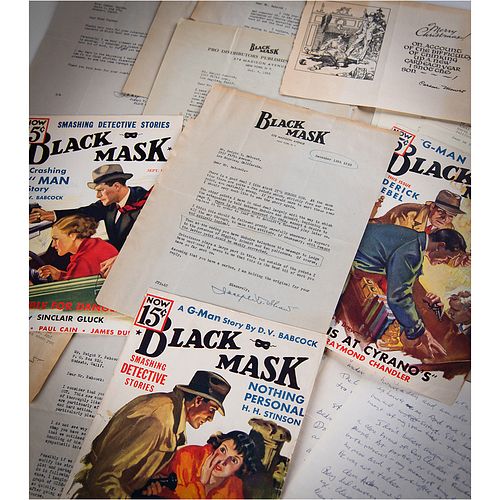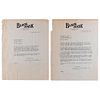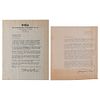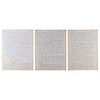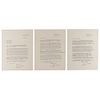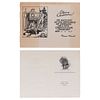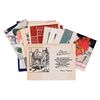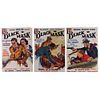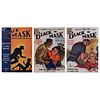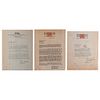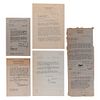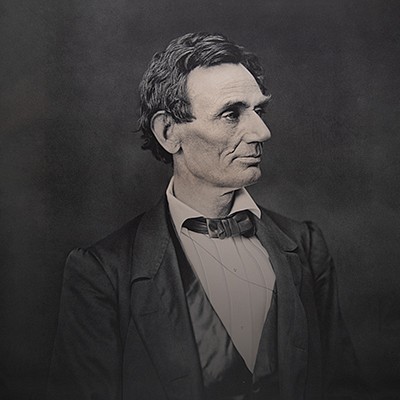Dwight V. Babcock: Black Mask Magazine Correspondence Archive with Editor Joseph Shaw
Two ways to bid:
- Leave a max absentee bid and the platform will bid on your behalf up to your maximum bid during the live auction.
- Bid live during the auction and your bids will be submitted real-time to the auctioneer.
Bid Increments
| Price | Bid Increment |
|---|---|
| $0 | $5 |
| $50 | $10 |
| $200 | $25 |
| $500 | $50 |
About Auction
Feb 14, 2024
RR Auction's February Fine Autographs and Artifacts auction boasts 600 unique items, and honors Presidents' Day with a special section featuring incredible presidential autographs, artifacts, and memorabilia. RR Auction support@rrauction.com
- Lot Description
Fascinating correspondence archive between writer Dwight V. Babcock and Joseph ‘Cap’ Shaw, the editor of Black Mask, an influential pulp magazine that launched the hardboiled crime subgenre of mystery fiction and published now-classic works by Dashiell Hammett, Raymond Chandler, Erle Stanley Gardner, Cornell Woolrich, Paul Cain, Carroll John Daly, and others. The archive contains 11 TLSs from Shaw, each signed “Joseph T. Shaw,” the majority on Black Mask letterhead dated between 1933 and 1936, with the bulk of the content featuring Shaw’s encouraging words and his candid editorial suggestions. Also included is a five-page handwritten outline for a letter sent by Babcock to Raymond Chandler biographer Frank MacShane, which includes Babcock’s thoughts on his experiences with Chandler, two TLSs from Dime Detective Magazine editor Kenneth White, a TLS from Shaw’s Black Mask successor Fanny Ellsworth, and an assortment of other letters, documents, and Christmas cards from Babcock’s publishers and fellow writers. Also of note is a telegram from Shaw asking Babcock to extend the editor’s warmest greetings to the attendees of the famous 1936 West Coast Black Mask writers' gathering at which Hammett and Chandler met for the first and only time.
Highlighted passages from Shaw’s letters are as follows, with all directed to Babcock unless otherwise noted:
December 15, 1933: “There is a good deal I like about IT'S MURDER NOW. At the same time there are quite a few points which, strictly from our viewpoint, are radically wrong. If you would care to work these over I should very much like to see the story again. The chief points I have in mind deal largely with the way in which the antagonism is told between McGuire and Schmidt, beginning on page 7. There is no reason apparent for this, except a desire to implant it in order to lead up to Schmidt's bonehead play later on. I think this should be followed pretty carefully wherever it appears all the way through, to make this attitude, if necessary, with reason and entirely logical.”
No date [circa late December 1933], Shaw forwards Babcock “a very enthusiastic fan letter on AT THE BOTTOM OF EVERY MESS from Miss Isabel Hughes...who congratulates us on your arrival in Black Mask.” A portion of the fan’s praise, reads: “I am writing to commend you on your choice of stories contained in the December issue of the BLACK MASK. I particularly enjoyed the fast-moving, clipped and concisive style of Dwight V. Babcock...It is such cleverly written stories as Mr. Babcock's characteristic number that make your magazine stand out from any magazine of its kind.”
December 26, 1933, sent to Black Mask fan Isabel Hughes, in part: “Thanks very much for your favor of December 20th with its kindly expression concerning the magazine, and particularly the stories by Dwight V. Babcock and William Rollins, Jr. We are glad to say that we have several more on the way by both of these authors.”
January 12, 1934: “I appreciate very much the effort you have given to the revision of IT'S MURDER NOW, and I have looked over the new pages carefully, but somehow it strikes me that even these do not quite lift the story to the level where I would like to have it both for your interests and for our own...I hope you won't consider this extra work wasted, for I do feel it has helped the story and should, therefore, help its salability. Meanwhile, I hope you will hit upon a subject and treatment that will carry on the good work you have already done.” Backing sheet to reverse of letter bears an affixed TLS from Leo J. Marguiles, the editorial director for Standard Magazines.
August 30, 1934: “Although you have massed the action in TOO MANY SLIPS in the climax, I consider it a very well done story and am pleased to enclose check herewith...I was very much interested in your letter and am glad that you have met Barnes with the prospect of seeing his partner Davis soon. Through correspondence, I have a very friendly feeling for both. Here's an idea: Every so often a bunch of the B. M. fellows come on here and we get together for a session and something of a pow wow, with accent on the wow. Last time, Dash Hammett officiated with the noble help of Whitfield and Nebel, and stragglers were being picked up the next day. Now there seems to be a very able coterie on the West Coast; yourself, Davis, Barnes, Erle Stanley Gardner, Raymond Chandler, Maffatt, with Roger Torrey planning to come that way before long, and perhaps some others. Why don't you also have a round-up? I'll speak to Gardner about it, as he is now in town and planning to be back there in a month or so. I know Davis is anxious to meet him.”
December 6, 1934: “This seems to be a comedy of errors, and goes to show how much devilment may be caused when trying to do too many things simultaneously in a short space of time. Thanks for sending me the pages of MURDER AFTER MIDNIGHT; but I have that story all tucked away in the Press and what I want are pages 44 to the end of DEATH'S RANSOM which came in without them. I wired with the idea of taking this story up for consideration for an early spot, but after all one makes haste more slowly. I do not know why I am apt to confuse the personalities of you and Mr. Ballard. It may be the alliterative B; or that you are both young and both of such excellent promise.”
December 14, 1934: “I like your story, DEATH'S RANSON, very much, and consider it, in its freshness and new angle, with the inclusion of likable characters and making the central, hero character more appealing and less of a ‘mugg,’ one of the best if not the best you have yet sent us. I believe, however, you can change, slightly, the ending to advantage.” Shaw then offers Babcock his suggested changes.
March 13, 1935: “Herewith please find a check for your excellent story, HIDE-OUT...The only other point that I wanted to add to my letter was regarding this chap's name, Chuck Thompson. This would be an excellent moniker.” This letter is affixed to the top of a secretarially signed letter from Shaw, dated March 11, 1935, also regarding his story Hide-Out.
April 1, 1935, sent to Isabel Hughes: “Thanks very much for your interesting letter with its kindly comments on BLACK MASK and your favorite characters and authors. Personally, I am very pleased at the progress that Dwight Babcock is showing. I consider the latest story that he has sent us, the best bit of work, by far as yet to come from his typewriter.”
October 9, 1935: “I have your letter with its interesting suggestion regarding collaboration with Ballard. I think it might be done best in the space of a novel; I have doubt whether two would have room enough in a novelette...Meanwhile, I have another idea for you to think over. I'm titling that story ‘G-MAN CHUCK THOMPSON.’ The idea is that there is a good opportunity to push Chuck as a character vigorously right now, while G-men stuff is popular...The idea would be to put Chuck in the many fields of activity which are the high spots with the Feds. You have infinite choice for variety — extortion, blackmail, counterfeiting, white slavery and so on. The point would be to make Chuck, not a superman, but a real, sure enough likable fellow and popularize him.”
August 28, 1936: “Before leaving the office I put in requisition for MURDER ON THE SIDE which I consider a darned good story...I'm writing now to tell you, promptly, that I am resigning from Black Mask, partly on a matter of policy and also because I want to pursue my own writing and other work. But I don't want to break relations with you and other members of the group with whom I have been working for some years past.”
Babcock’s handwritten outline draft on Raymond Chandler (the second page of which is missing), reads, in part: “I don't believe anyone I know or knew then was really a close friend of Ray Chandler. He and Cissy were very private people. At parties or social rendezvous - those where we were both present - my memory of him is mostly of him sitting with his pipe and a cup of coffee or tea, observing others. He was not a talker...We all looked on Ray in those days with some envy for his ability, and amusement or wonder because he obviously was personally so unlike the people he was writing about. In other words, like the rest of us, he was drawing on his imagination - but apparently in a greater degree. We felt he was deliberately writing like Hammett, a little more colorful perhaps. But Hammett wrote out of his experience and he was like the characters he wrote about. In other words, Ray C was an imitator. He came into B.M. [Black Mask] writing in Hammett's style - much closer than any of the rest of us would dare to. But he did it so well and was so talented, he succeeded at it. Ray himself said he preferred to read the English drawing-room-type mystery - Agatha Christie, etc. Yet he wrote tough.” This outline is accompanied by three TLSs from MacShane, asking for said outline (“I have been commissioned to write the authorized biography of Raymond Chandler”) and thanking Babcock for his remembrances.
The Kenneth White letters:
July 28, 1934: “Just got back from a three weeks vacation to find ‘What Price Publicity’ on my desk. I have decided to use it as a substitution for a too long novelette that made the September 15th issue run over...There were a couple of things in the story that had to be changed before I could use it, and as there wasn't time to send it back to you for revision, they were made here in the office. May I caution you in future stories about the use of negro characters. We steer completely away from them unless in the case of a particularly old, traditional and loyal family retainer on whom no slight suspicion of crime or dickey-dealing might possibly fall, in which case it's okay to use one of the sons of Ham. I changed the colored female servant to a quarter breed Indian girl whom Miss Winters picked up in New Mexico, and the big buck negro to a ‘breed’ with a knife, also deleting the negro dialogue.”
April 10, 1935: “Sorry to have to send ‘DEATH GOES FREE’ back to you but I don't think this type of story, dealing, as it does, with the ‘John Dillinger’ type of bad-man bandit, has sufficient of the detective mystery elements that we need for Dime Detective - a little too newspaper-head-line in interest for us.”
The Fanny Ellsworth letter:
September 2, 1936: “Perhaps you've heard that Captain Shaw has resigned as editor of Black Mask. From now on, I shall be trying to take his place with the aid of J. B. Magill as managing editor. We hope we shall be able to maintain the high standard Captain Shaw has set us, and trust that all contributors will continue to feel at home with the magazine. Captain Shaw has left us one of your stories, ‘MURDER ON THE SIDE,’ which we think a nice straightforward yarn, and we hope to see others equally good.”
Norbert Davis TLS
July 24, 1949: “Yeah, I'm still alive. Surprised? I am. Thanks a lot for your postal note. I've been meaning to write you before, but things have just been proceeding slowly along the old route from desperate to dismal to down-right damnedable, and that leads to the sort of correspondence that is anything but cheery reading. I've just gotten myself thoroughly foxed and fouled up here, and there doesn't seem to be any light leading out in any direction. What comes next, I don't know, but I'll be finding out soon, no doubt.
I've spent quite a few nights trying to puzzle things out as if it made much difference and the best results I can get is either that I suddenly lost my touch when it came to writing saleable stuff of the type I was doing, or else that everyone got sick of it at the same time. I suppose I should have switched fields before I came to this pretty little pass, but somehow I never was able to sight a trend until it clipped me in the back of the neck.
This is really a nice spot here or could be. It's not SO nice at the moment because the landlord has filed an eviction suit against me. The hearing is on the 30th, and I'm looking forward to that with a great deal of glee. I did the best for him I could, but it wasn't quite good enough. He probably sensed that I was flat, although I have been trying to put on an air of financial means. The Cape, itself, is pretty nice, and the beaches and the ocean are much nicers than the Pacific I do believe. Not so cold and not so much ranting and roaring. Of course, I'm not counting the winter, when the neighborhood is infested with sleet storms according to reliable rumour.” Babcock was a close personal friend of famed Black Mask writer and novelist Norbert Davis, who, as this letter plainly illustrates, was struggling to make ends meet. Four days after the letter was written, Davis killed himself at a Harwich, Massachusetts cottage. The motivation for Davis’s suicide has only been guessed at in recent pulp fiction chronologies.
Also included are TLSs from Street & Smith editors John Nanovic and E. C. Richards, Dodge Publishing editor Critchell Rimington, Erle Stanley Gardner’s secretary, Jean Bethell, and Robert Thomas Hardy, Inc., concerning policy changes to Black Mask. In overall very good to fine condition. Accompanied by six detached front covers from Black Mask magazine, many listing Babcock as a featured writer, and 11 vintage Christmas cards and telegrams from Shaw and fellow writers like Norbert Davis and his wife Frances Crane, Eric Taylor, Todhunter Ballard, Carson W. Mowre, and more. - Shipping Info
-
Bidder is liable for shipping and handling and providing accurate information as to shipping or delivery locations and arranging for such. RR Auction is unable to combine purchases from other auctions or affiliates into one package for shipping purposes. Lots won will be shipped in a commercially reasonable time after payment in good funds for the merchandise and the shipping fees are received or credit extended, except when third-party shipment occurs. Bidder agrees that service and handling charges related to shipping items which are not pre-paid may be charged to a credit card on file with RR Auction. Successful international Bidders shall provide written shipping instructions, including specified Customs declarations, to RR Auction for any lots to be delivered outside of the United States. NOTE: Declaration value shall be the item’(s) hammer price and RR Auction shall use the correct harmonized code for the lot. Domestic Bidders on lots designated for third-party shipment must designate the common carrier, accept risk of loss, and prepay shipping costs.
-
- Buyer's Premium



 EUR
EUR CAD
CAD AUD
AUD GBP
GBP MXN
MXN HKD
HKD CNY
CNY MYR
MYR SEK
SEK SGD
SGD CHF
CHF THB
THB